Humanity’s relationship with the sea dates back eons. It has been a bountiful resource, serving as a source for food, an avenue for trade and discovery, and more recently, a source of energy.
However, the sea can bite back. Settlements near coastlines have long needed to be protected from its destructive power, and for nearly 2,000 years, communities have been building walls to hold back the tide.
While the Greeks and Romans built jetties and harbors to aid with loading and unloading goods and people, coastal defense was not their purpose. The first proper seawall is said to have been constructed in 195 AD in Byzantium, now modern-day Istanbul.
Seawall definition:
According to the European climate adaptation platform Climate-ADAPT, a partnership between the European Commission and the European Environment Agency, a seawall is a structure “made of concrete, masonry or sheet piles, built parallel to the shore at the transition between the beach and the mainland or dune, to protect the inland area against wave action and prevent coastal erosion.”
Climate-ADAPT says seawalls provide a high degree of protection against coastal flooding and erosion, fix the boundary between the sea and land to protect important infrastructure or buildings, and have a lower space requirement than other coastal defenses such as dikes.
The height of a seawall can be raised to face an increase in sea level, while Climate-ADAPT says the high level of security provided by a seawall favors the development of the land behind it.
Even concrete seawalls are not impenetrable, however. They can be breached, as famously occurred seven years ago off the coast of Essex, in eastern England, when a 300-meter (1,000-foot) section of wall was overwhelmed at Fingringhoe Wick, on the Colne Estuary.
Protecting the UK’s vulnerable coast
The UK has long risked the wrath of the sea. Estimates of the length of the country’s coastline vary, but the Ordnance Survey suggests it is just over 11,000 miles.
Protecting the many sea-facing communities arranged along the coastline from the elements has been a priority for centuries and is becoming even more pressing, given the growing threat of climate change, which could exacerbate regular and predictable storm surges.
According to the Committee on Climate Change (CCC), in England, 520,000 properties (including 370,000 homes) are located in areas with a 0.5% or greater annual risk from coastal flooding. This could rise to 1.5 million buildings, including 1.2 million homes, by the 2080s.
This adds weight to the debate around coastal protection. According to the CCC, economic damages from flooding and erosion come in at more than £260 million ($320 million) a year.
Those proposing flood defenses have traditionally favored “hard engineering” solutions, such as seawalls and depositing huge boulders to break up waves as they come ashore. “Soft” engineering comprises solutions such as shingle or creating and maintaining sand dunes.
Pros and cons of protective measures
Some academics highlight a more natural approach, such as using salt marshes or planting grasses and plants to stem coastal erosion. Of course, there are advantages and disadvantages to any of the proposed solutions.
While they offer protection for buildings and transport links, seawalls do have their disadvantages. One of these is cost. According to Climate-ADAPT, costs for seawalls “vary according to the type of construction, dimensions, availability and proximity of construction materials, anticipated rates of future erosion and wave loadings, facilities such as walkways and steps or slipways.”
Sometimes the seawall construction cost makes it uneconomic. Such a sea defense system along 9 km (6 mi) of coastline at Pevensey Bay in Sussex would cost between £5,000 ($6,000) and £10,000 ($12,000) per linear meter, according to Pevensey Coastal Defence Ltd (PVD), part of a public/private partnership venture between the Environment Agency and others.
That would mean £75 million ($94 million) for the construction alone, not including maintenance, which PVD estimated could amount to £1 million ($1.25 million) a year. Coastal communities like Pevensey are also mindful of the environmental impact of a seawall, which some argue could be detrimental to local species of plants and wildlife, as well as the scenic beauty of that stretch of East Sussex.
Government funding has its limits, and potential schemes need to be costed even more forensically to justify their value.
What are seawalls made of?
If a seawall was the preferred option, what would it be made of? Steel is regarded as one of the best materials to use, given its strength and durability. However, it requires high and regular maintenance, including regular applications of protective coating to fend off corrosion.
A concrete seawall and other masonry is also popular. Concrete would be pre-cast, with molded features such as slopes and curved summits designed to reduce and deflect the power of incoming waves. As with steel, concrete can be susceptible to corrosion in certain conditions, and protective measures would be needed.
Some seawalls are made of softer material, such as sand or shingle, the rationale being they offer protection with less impact on the surrounding environment.
Whatever the material used, as marine and coastal environments become more unpredictable, planning authorities, local and central government and the sea-facing communities themselves will need to consider the options that are right for their circumstances.
Designers and engineers should also consider using digital twin and other software technology to run “what if” scenarios, helping to assess the likely impact on a proposed scheme of the increasing number of storm surges, high tides and storms being experienced today.











